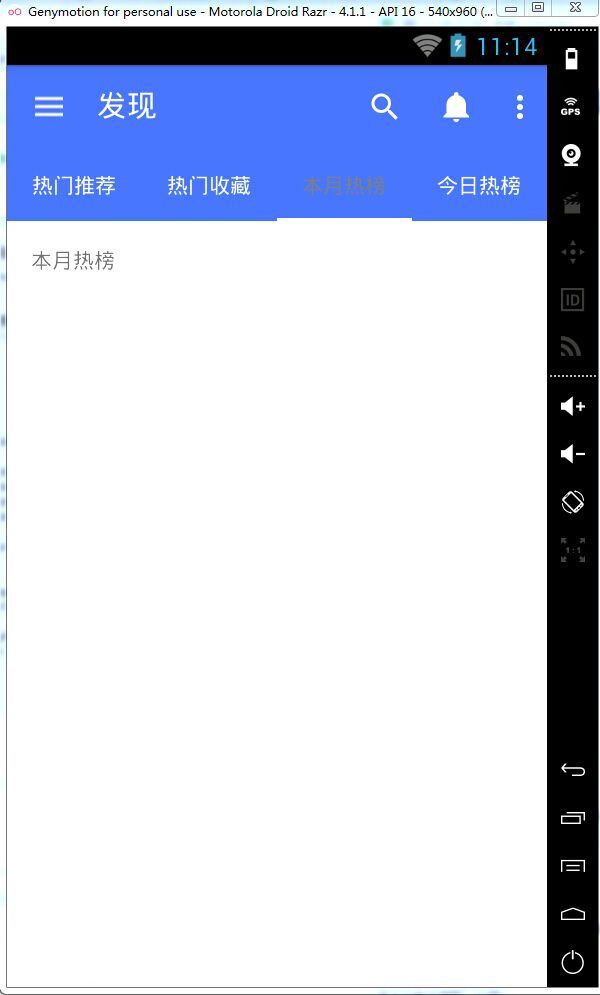Android TabLayout(选项卡布局)简单用法实例分析
本文实例讲述了Android TabLayout(选项卡布局)简单用法。分享给大家供大家参考,具体如下:
我们在应用viewpager的时候,经常会使用TabPageIndicator来与其配合。达到很漂亮的效果。但是TabPageIndicator是第三方的,而且比较老了,当然了现在很多大神都已经开始自己写TabPageIndicator来满足自己的需求,在2015年的google大会上,google发布了新的Android Support Design库,里面包含了几个新的控件,其中就有一个TabLayout,它就可以完成TabPageIndicator的效果,而且还是官方的,最好的是它可以兼容到2.2以上版本,包括2.2。下面我就举一个简单的例子来使用它。
这里使用的 android studio进行开发的,所以引用TabLayout很简单,只要在build.gradle中加入compile 'com.android.support:design:22.2.0'即可。
这个使用是我在仿 知乎 的时候使用。所以页面就和知乎很像了
fragment_find.xml
|
1
2
3
4
5
6
7
8
9
10
11
12
13
14
15
16
17
18
19
20
21
|
<
LinearLayout
xmlns:android
=
"http://schemas.android.com/apk/res/android"
android:layout_width
=
"match_parent"
android:layout_height
=
"match_parent"
xmlns:app
=
"http://schemas.android.com/apk/res-auto"
android:orientation
=
"vertical"
>
<
android.support.design.widget.TabLayout
android:id
=
"@+id/tab_FindFragment_title"
android:layout_width
=
"match_parent"
android:layout_height
=
"wrap_content"
android:background
=
"@color/titleBlue"
app:tabIndicatorColor
=
"@color/white"
app:tabSelectedTextColor
=
"@color/gray"
app:tabTextColor
=
"@color/white"
/>
<
android.support.v4.view.ViewPager
android:id
=
"@+id/vp_FindFragment_pager"
android:layout_width
=
"fill_parent"
android:layout_height
=
"0dp"
android:layout_weight
=
"1"
/>
|
这里面没有什么特别的,就是添加了一个TabLayout和Viewpager作为上下的布局。其中
|
1
2
3
|
app:tabIndicatorColor=
"@color/white"
// 下方滚动的下划线颜色
app:tabSelectedTextColor=
"@color/gray"
// tab被选中后,文字的颜色
app:tabTextColor=
"@color/white"
// tab默认的文字颜色
|
Find_tab_Adapter.java 它是viewpager的Adapter,因为这里面我每个栏目下,都会有一些列表,所以采用list
|
1
2
3
4
5
6
7
8
9
10
11
12
13
14
15
16
17
18
19
20
21
22
23
24
25
26
27
28
29
30
|
package
com.example.cg.myzhihu.Adapters;
import
android.support.v4.app.Fragment;
import
android.support.v4.app.FragmentManager;
import
android.support.v4.app.FragmentPagerAdapter;
import
java.util.List;
/**
* Created by cg on 2015/9/26.
*/
public
class
Find_tab_Adapter
extends
FragmentPagerAdapter {
private
List
//fragment列表
private
List
//tab名的列表
public
Find_tab_Adapter(FragmentManager fm,List
super
(fm);
this
.list_fragment = list_fragment;
this
.list_Title = list_Title;
}
@Override
public
Fragment getItem(
int
position) {
return
list_fragment.get(position);
}
@Override
public
int
getCount() {
return
list_Title.size();
}
//此方法用来显示tab上的名字
@Override
public
CharSequence getPageTitle(
int
position) {
return
list_Title.get(position % list_Title.size());
}
}
|
FindFragment.java这个的说法,全在标注里面了
|
1
2
3
4
5
6
7
8
9
10
11
12
13
14
15
16
17
18
19
20
21
22
23
24
25
26
27
28
29
30
31
32
33
34
35
36
37
38
39
40
41
42
43
44
45
46
47
48
49
50
51
52
53
54
55
56
57
58
59
60
61
62
63
64
65
66
67
68
69
70
71
72
|
package
com.example.cg.myzhihu;
import
android.os.Bundle;
import
android.support.design.widget.TabLayout;
import
android.support.v4.app.Fragment;
import
android.support.v4.app.FragmentPagerAdapter;
import
android.support.v4.view.ViewPager;
import
android.view.LayoutInflater;
import
android.view.View;
import
android.view.ViewGroup;
import
com.example.cg.myzhihu.Adapters.Find_tab_Adapter;
import
java.util.ArrayList;
import
java.util.List;
/**
* 发现页面
*/
public
class
FindFragment
extends
Fragment {
private
TabLayout tab_FindFragment_title;
//定义TabLayout
private
ViewPager vp_FindFragment_pager;
//定义viewPager
private
FragmentPagerAdapter fAdapter;
//定义adapter
private
List
//定义要装fragment的列表
private
List
//tab名称列表
private
Find_hotRecommendFragment hotRecommendFragment;
//热门推荐fragment
private
Find_hotCollectionFragment hotCollectionFragment;
//热门收藏fragment
private
Find_hotMonthFragment hotMonthFragment;
//本月热榜fragment
private
Find_hotToday hotToday;
//今日热榜fragment
@Override
public
View onCreateView(LayoutInflater inflater, ViewGroup container,
Bundle savedInstanceState) {
View view = inflater.inflate(R.layout.fragment_find, container,
false
);
initControls(view);
return
view;
}
/**
* 初始化各控件
* @param view
*/
private
void
initControls(View view) {
tab_FindFragment_title = (TabLayout)view.findViewById(R.id.tab_FindFragment_title);
vp_FindFragment_pager = (ViewPager)view.findViewById(R.id.vp_FindFragment_pager);
//初始化各fragment
hotRecommendFragment =
new
Find_hotRecommendFragment();
hotCollectionFragment =
new
Find_hotCollectionFragment();
hotMonthFragment =
new
Find_hotMonthFragment();
hotToday =
new
Find_hotToday();
//将fragment装进列表中
list_fragment =
new
ArrayList<>();
list_fragment.add(hotRecommendFragment);
list_fragment.add(hotCollectionFragment);
list_fragment.add(hotMonthFragment);
list_fragment.add(hotToday);
//将名称加载tab名字列表,正常情况下,我们应该在values/arrays.xml中进行定义然后调用
list_title =
new
ArrayList<>();
list_title.add(
"热门推荐"
);
list_title.add(
"热门收藏"
);
list_title.add(
"本月热榜"
);
list_title.add(
"今日热榜"
);
//设置TabLayout的模式
tab_FindFragment_title.setTabMode(TabLayout.MODE_FIXED);
//为TabLayout添加tab名称
tab_FindFragment_title.addTab(tab_FindFragment_title.newTab().setText(list_title.get(
0
)));
tab_FindFragment_title.addTab(tab_FindFragment_title.newTab().setText(list_title.get(
1
)));
tab_FindFragment_title.addTab(tab_FindFragment_title.newTab().setText(list_title.get(
2
)));
tab_FindFragment_title.addTab(tab_FindFragment_title.newTab().setText(list_title.get(
3
)));
fAdapter =
new
Find_tab_Adapter(getActivity().getSupportFragmentManager(),list_fragment,list_title);
//viewpager加载adapter
vp_FindFragment_pager.setAdapter(fAdapter);
//tab_FindFragment_title.setViewPager(vp_FindFragment_pager);
//TabLayout加载viewpager
tab_FindFragment_title.setupWithViewPager(vp_FindFragment_pager);
//tab_FindFragment_title.set
}
}
|
效果图,不太会做成动态的:
